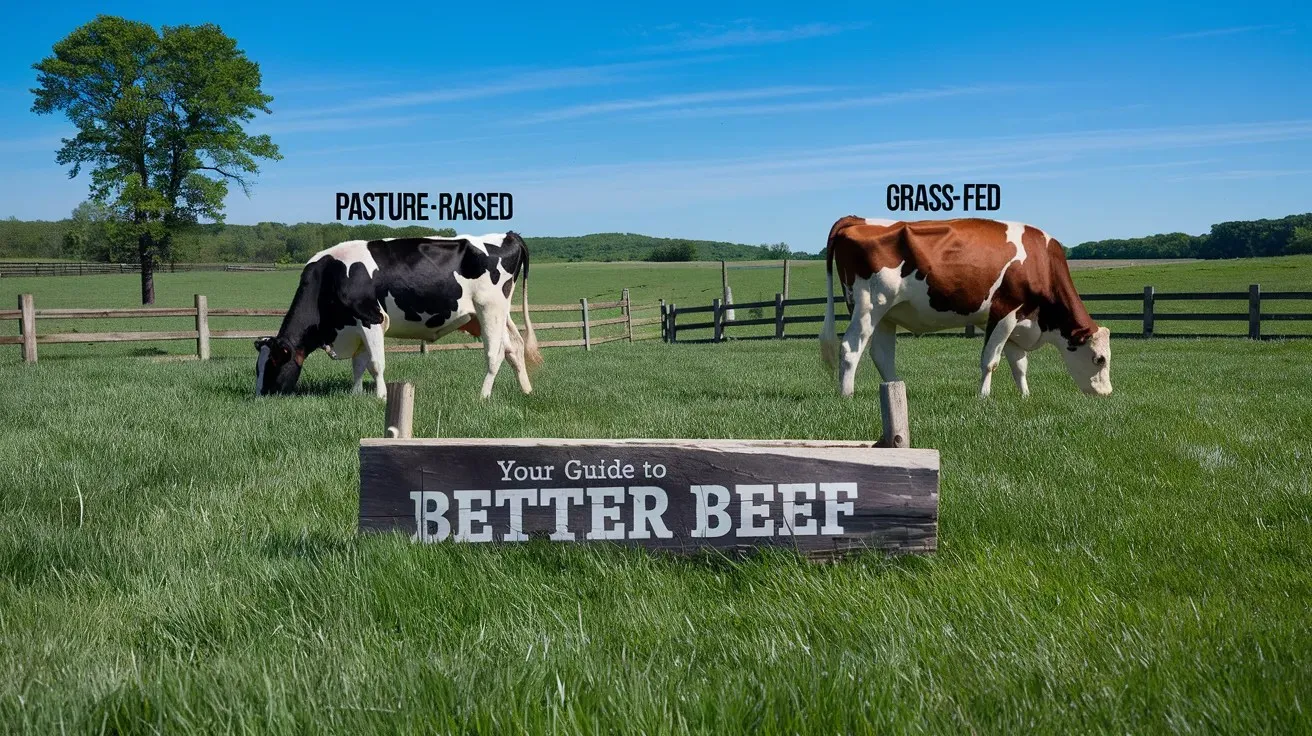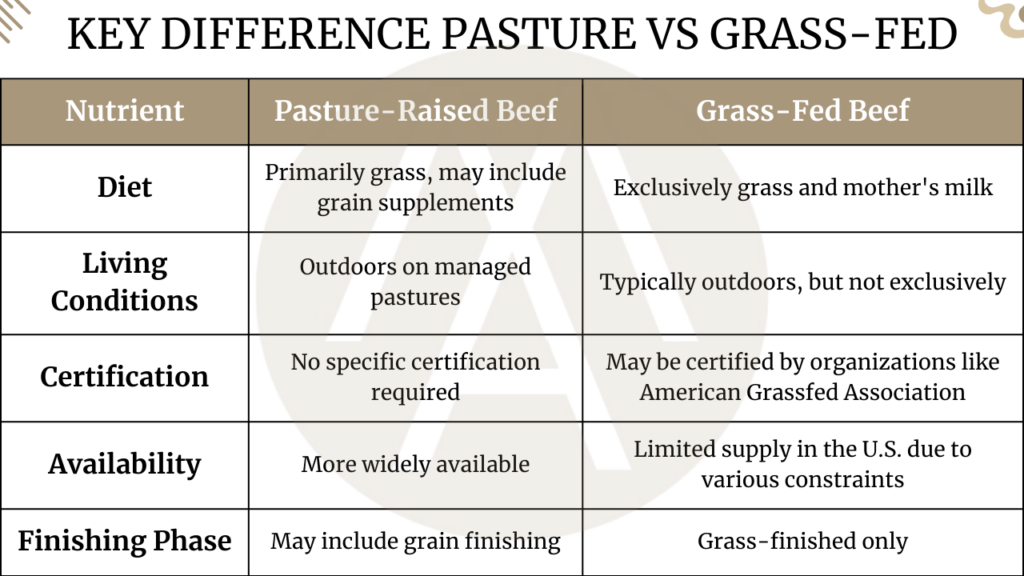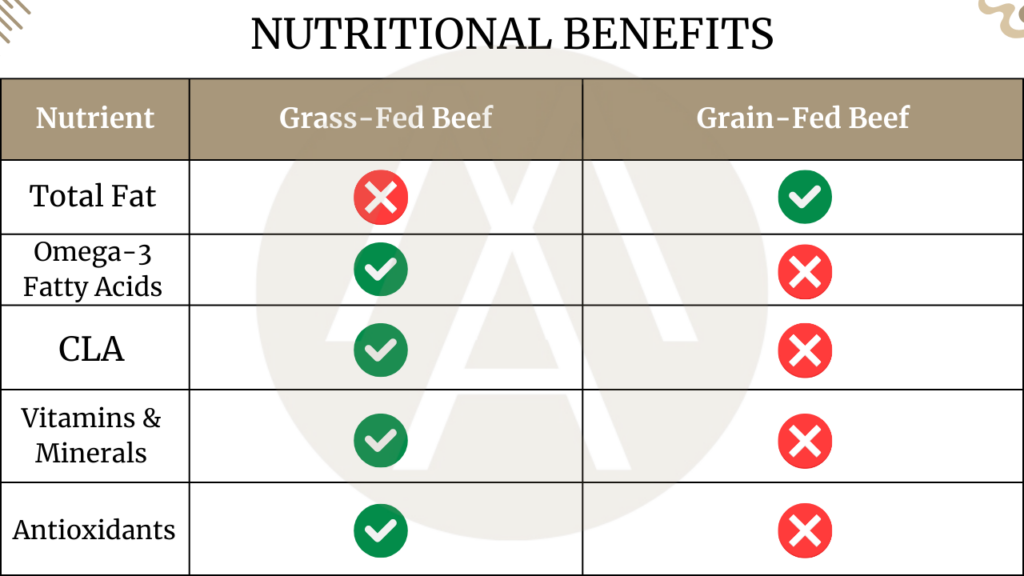Physical Address
304 North Cardinal St.
Dorchester Center, MA 02124
Physical Address
304 North Cardinal St.
Dorchester Center, MA 02124

Lost in the confusing world of 'grass-fed' vs. 'pasture-raised' beef? Discover the shocking truths behind these labels, the real nutritional benefits, and the surprising differences in taste and sustainability. Don’t waste your money or compromise your values—click now to become a beef-buying expert in minutes!
Have you ever just stood in front of the meat section at your local grocery store, staring down the labels “pasture-raised” and “grass-fed“? You are not alone. The world of beef production can get a little confusing, packed with terms that at times sound similar but actually mean different things.
But seriously, who can make good choices with such baffling labels?
Don’t worry, we’ll clear the confusion and turn you into an informed, savvy beef buyer. Todays’ article will discuss pasture-raised versus grass-fed beef for their nutritional benefit, debunk some common myths, and compare taste and texture.
By the end, you’ll be equipped to make an informed choice that aligns with your values and preferences. Ready to become a beef connoisseur? Let’s dive into the juicy details that will simplify your next trip to the butcher or restaurant!

Pasture-raised beef refers to beef from cattle that are raised on managed pastures. The animals are mostly outdoors, spending their days under fresh air and open space. Even though pasture-raised cattle mainly feed on grass, they may be supplemented with grain, especially during winter when forage is in short supply and too expensive for the farmer.
Grass-fed beef refers to those cattle that only consume grass and their mother’s milk from birth to harvest. Unlike pasture-raised beef, no grain is ever introduced to these animals in their lifetime. All grass-fed beef is pasture-raised, but not all pasture-raised beef is grass-fed.
To more clearly explore the differing practices in pasture-raised versus grass-fed beef, consider the following comparison:

Key differences to remember include the following:
With that said, let’s progress to the following section and touch on some of the nutritional benefits pasture-raised beef has.
Now that we’ve explored the different beef production methods, let’s dive into the nutritional benefits of pasture-raised beef. You will realize that this type of beef has several advantages over conventional grain-fed ones.
When you choose pasture-raised beef, you are choosing a meat that is richer in omega-3 fatty acids. These essential fats are well-documented to be heart-healthy due to their anti-inflammatory effects and lowering the risk of heart disease. While the omega-3 levels in beef, when compared to more fatty fish like salmon, remain generally low, pasture-raised beef does still give a notable boost over its grain-fed counterpart.
Pasture-raised beef is a very good source of vitamin E, an antioxidant nutrient. Vitamin E protects cells from damage and supports the immune system. Because pasture-raised cattle eat a diet that is higher in grass and other forage, and lower in grain, than conventionally raised cattle, the levels of this vitamin are higher.
Another nutritional highlight for pasture-raised beef is CLA, conjugated linoleic acid. This fatty acid has been associated with improved immunity, reduction of inflammation, and even possessing potential cancer-fighting properties. You can find significantly more CLA in pasture-raised beef than you would in the grain-fed alternatives.
If fat is a concern for you, then pasture-raised beef is a great choice. It will generally have less total fat and fewer calories when compared to grain-fed beef1. Here’s a comparison of the nutritional content in a 4-ounce serving of raw ground beef:
| Type of Beef | Calories | Protein | Fat |
|---|---|---|---|
| Grain-fed | 280 | 20g | 22g |
| Pasture-raised | 224 | 22g | 14g |
As you can see, pasture-raised beef provides more protein with significantly less fat, making it leaner for your meals.
Besides all that, pasture-raised beef will also often be without added hormones and antibiotics, as generally fits the preference for naturally raised meat on this site. Rotational grazing is a practice of regenerative farms that, along with improving animal welfare, makes for healthier animals and better nutritional profiles in the meat2.
With all these nutritional benefits in mind, let us explore some of the common myths regarding pasture-raised beef to help you make a very informed decision regarding your meat intake.

Now that we have discussed the nutritional benefits of pasture-raised beef, let’s clear some misconceptions that people have regarding this meat.
Many consumers wonder about pasture-raised beef, particularly about its price and availability.
You may wonder why pasture-raised beef is more expensive. Here’s why:
| Factor | Conventional Beef | Pasture-Raised Beef |
|---|---|---|
| Diet | Grain-based | Natural grass and forage |
| Living Conditions | Confined feedlots | Open pastures |
| Environmental Impact | Higher | Lower, supports biodiversity |
| Nutrient Content | Standard | Higher in omega-3s and vitamin E |
You might have heard that pasture-raised beef is hard to find, but that is increasingly a myth. Here’s what you need to know:
Where to find it:
To ensure that you are getting real pasture-raised beef, look for the certifications “Certified Grassfed” and “American Grassfed” when purchasing.

With full knowledge of the price and availability of pasture-raised beef, you may make better choices in choosing meat.
We move on to discuss grass-fed beef-what it offers to derive advantages similar to pasture-raised, but with a number of distinctive characteristics.
Having cleared some of the misconceptions regarding pasture-raised beef, let’s look at some of the most important advantages of grass-fed beef.
Grass-fed beef is leaner, containing fewer calories and less fat. Here’s why:
| Beef Type | Calories (4 oz serving) | Protein | Fat |
|---|---|---|---|
| Grass-fed | 224 | 22g | 14g |
| Grain-fed | 280 | 20g | 22g |
Grass-fed beef is rich in antioxidants and contains higher levels of essential nutrients like B vitamins and vitamin D5. It also has more omega-3 fatty acids than grain-fed beef, which can support heart health, and provides more Conjugated Linoleic Acid (CLA)6, known to boost the immune system and reduce inflammation.

By choosing grass-fed beef, you support better agricultural practices and reduce environmental degradation:
By consuming grass-fed beef, you’ll be supporting healthier and happier cows:
With that in mind, the not-so-good news is that with any high-quality beef breed, there are always myths flying around.
The following section will debunk these myths, giving you a better idea of grass-fed beef. What are some concerns you might have? We’ll address them in a second.

Now that we’ve explored the advantages of grass-fed beef, let’s debunk some common myths surround this popular meat choice. Knowing these myths will better position you with regard to choices surrounding your consumption of beef.
You might assume that ‘grass-fed’ means the cattle eat nothing but grass their whole life. But that’s not always true:
Look for reputable sources who follow strict guidelines, like SunFed Ranch, which ensures that their cattle are never confined to feedlots or given antibiotics or hormones.
Not all grass-fed beef is created equally; rather, nutritional profiles can vary depending on cattle breed, the diversity of their pasture, and farming practices.
Here’s a comparison of some nutritional benefits in grass-fed beef:

Grass-fed is generally leaner and higher in nutrients, but sourcing from farms that adopt more sustainable methods and take better care of their animals is also of great importance.
Now that you have set aside a number of the myths surrounding grass-fed beef, you’re better prepared to enjoy its taste and texture. We’re now going to take you through grass-fed versus grain-fed beef when it comes down to taste to assist you in making an informed choice about this healthy option.

Now that we have debunked some of the more common misconceptions about grass-fed beef, let’s dive into the sensual aspects of both pasture-raised and grass-fed beef.
You will be glad to know that pasture-raised beef has a different flavor profile-one that is unique and delicious. Here is what you should expect (don’t take it as a fact, taste is subjective):
This is because pasture-raised cattle have a diverse diet that may include many types of grass and herbs. You will like the depth of taste coming from these animals raised naturally, as their diet is mostly pure.
Now, when it comes to the texture, grass-fed beef presents some uniqueness:
This in turn is a result of the grass-only diet and increased physical activity of the cattle. You may find that you need to chew grass-fed beef a little bit more, but most lovers of the meat would mark this as an indication of the quality and naturalness of the meat.
To appreciate every variation in flavor and texture, in pasture-raised versus grass-fed beef, you will have to change your cooking techniques:
| Beef Type | Cooking Tips |
|---|---|
| Pasture-raised | – Cook at lower temperatures – Use moist-heat methods for tougher cuts – Avoid overcooking to preserve flavor |
| Grass-fed | – Reduce cooking time by 30% – Use marinades to enhance tenderness – Let rest longer after cooking |
Remember, both these cuts cook more quickly than traditional cuts of beef because they have less fat in them. You will want to watch the temperature carefully so you don’t overcook them.
Now, moving on, we look at which might be the better choice for you, considering some other options besides flavor and texture.
Now that we have gone through the differences in taste and texture of these two kinds of meats, let’s take a closer look at which one will be better for you.
Pasture-raised and grass-fed beef possess certain nutritional attributes as compared to conventionally raised beef:
Both ways of farming encourage healthy ecology:
| Aspect | Grass-Fed | Pasture-Raised |
|---|---|---|
| Soil Health | Improves through rotational grazing | Enhances biodiversity |
| Carbon Sequestration | Yes | Yes |
| Pesticide Use | Reduced | Reduced |
| Ecosystem | Promotes thriving ecosystem | Creates balanced environment |
You’ll find that both methods prioritize animal welfare, but in slightly different ways:
Your choice between grass-fed and pasture-raised will come down to:
Also, when purchasing, you may want to check for labels such as “100% grass-fed” or “100% pasture-raised” to ensure you get exactly what you pay for. Another consideration: While all grass-fed beef, by its very definition, is pasture-raised, not all pasture-raised cattle are fed a diet of pure grass.
Let me repeat: Either of the two options you choose supports better agriculture and offers advantages over conventional beef. You are not just choosing a product; you are choosing a better way of raising your meat-one that is kinder and more environment-friendly.
No, it is not necessary that a pasture-raised cow will automatically come under the category of a grass-fed cow, as it may still be fed grains despite having access to open fields.
The grass-fed cattle get grass throughout their whole life. Actually, the “grass-fed” misleading term doesn’t give assurance of what the animals ate.
Not necessarily. Grass-fed cows are allowed only to eat grass and hay but that does not mean that they can roam in those wide open spaces. Some grass-fed cattle may also be kept in smaller confines and still eat their usual grass-based food.
While 100% grass-fed beef is a great addition to a natural diet, it in no way signifies that the cattle were pasture-raised. If you want to know that you are getting both grass-fed and pasture-raised beef, then find those labels that say both.
The choice between pasture-raised and grass-fed beef depends on what you prefer:
| Attribute | Pasture-Raised | Grass-Fed |
|---|---|---|
| Diet | May include grains | Grass and hay only |
| Living Conditions | Open fields | Not guaranteed |
| Nutritional Profile | Varies | Generally leaner |
| Environmental Impact | Generally positive | Often more sustainable |
To make an informed choice:
Generally, personal taste and talking directly to a producer are much better ways to find the best buys rather than relying on a simple label.
Comments are closed.
[…] grass-fed butter, and tallow are all animal-derived fats with unique characteristics. Ghee is clarified […]
[…] Pasture-Raised Vs. Grass-Fed: Your Guide To Better Beef […]
[…] Pasture-Raised Vs. Grass-Fed: Your Guide To Better Beef […]